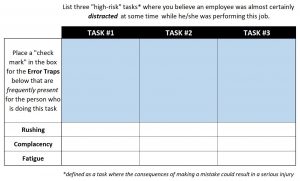 “The toolbox topic for today is chemical safety,” the supervisor said as he looked down at the information sheet he was holding. “The first group of chemicals we will review are known as acids. Strong acids have a pH that is significantly less than 7. Some examples include…”
“The toolbox topic for today is chemical safety,” the supervisor said as he looked down at the information sheet he was holding. “The first group of chemicals we will review are known as acids. Strong acids have a pH that is significantly less than 7. Some examples include…”
With this introduction, the warehouse crew in the room immediately tuned out. Some looked at the ceiling. Some stared at their shoes. Some even took a quick peek at their cell phones.
Too often, we view safety conversations as simply something that has to be done. We know these conversations are a responsibility of any leader. However, when we talk with employees about safety, our conversations are often reactive and seldom well-planned.
If a safety meeting is conducted where the primary goal of the leader is to “check the box” for a required training, the response is predictable. When employees realize the objective, there is no engagement. Most attendees stare blankly or watch the clock. Group meetings such as these should not even be considered as “conversations.” They have almost no impact in terms of engagement, learning, or mindset.
In this article, we will discuss three essential attributes for proactive safety conversations to have a positive impact. Think of these as the 3 P’s of an effective proactive conversation:
- Principled
- Prevalent
- Personalized
Principled
In a previous article, I explained the importance of starting every safety conversation with the right “why.”
“If the reason you have any safety conversation is because you care, your approach will be to coach and seek commitment through collaboration.”
Your employees need to know that you care about them. If their perception is that you are going through the motions or simply satisfying a requirement, they will disengage.
You may indeed have to occasionally review rules or policies. Almost every organization has certain safety topics that are mandated. It makes a significant difference if you deliver these messages with a “why” of caring.
It does not matter if you hold a one-on-one safety conversation or if you talk to an entire work group. It does not matter if the topic of the conversation is mandatory or not. Regardless, you are more effective and your message has more impact when your motive is based upon a core principle of personal caring.
Prevalent
There are three situations when safety conversation topics can be considered prevalent: Significant hazards, common risks, and potential error traps.
-
In many work environments, hazards are everywhere. However, some hazards are more significant in terms of their potential to cause a serious injury. Identify tasks where there is a significant hazard. Proactive conversations with this focus could be the difference in whether someone is exposed to a hazard that results in a life-changing event.
-
Similarly, it is not unusual for people who perform certain tasks to take the same risk. Their decision to take an unnecessary risk could be rooted in a false perception that they are not likely to get hurt. Or perhaps they are influenced to take this risk because an obstacle makes it difficult to do the job the safe way. Regardless, a safety conversation that probes the reasons why someone might be influenced to take a risk can be revealing.
-
People are fallible. We make mistakes. Frequently, we are exposed to error traps in the workplace (situations or conditions that make it more likely for us to make a mistake). Understanding error traps and collaborating with the employee to mitigate these are extremely effective in reducing the likelihood of human errors that can lead to injuries or incidents.
Personalized
Let’s go back to the warehouse crew. Obviously, chemical safety was not meaningful to this group of employees. (Unless, of course, they were handling, transporting, or loading chemicals). The topic was not personalized.
The first question these employees asked themselves when the meeting started was WIIFM (What’s in it for me?). As soon as they determined the answer to this question (“not much!”), they mentally checked out.
It is your responsibility to make a personal connection between the topic and your audience. If the safety conversation is not related to (1) a job that they do or (2) a place where they are active, it will be difficult or impossible to keep their attention.
Principled, Prevalent, and Personalized
So, which proactive safety conversations have the most impact?
An effective proactive safety conversation always starts with a “why” of caring. It has the potential for high impact when the topic addresses a significant hazard, risk, or error trap AND these situations are present in the work being done or the areas where the employee is engaged in an activity.

As an example, which one of these conversations is more likely to have a greater impact?
- Reminding an employee to wear their required PPE (personal protective equipment).
- Encouraging an employee to think about the ways (and the reasons) that he could end up in the line-of-fire while performing a task.
You should not avoid having the first conversation. However, these kinds of topics tend to be one-sided, reactive, and shallow. In addition, the message is frequently delivered from a compliance motive. (Note that even a reminder about PPE could be more impactful if you express genuine concern and make a connection to the employee’s specific task or activity).
Compare the PPE example with the second example of a conversation. This one is open-ended. It invites a dialogue. It has the potential to engage the employee in a “What if…?” thought experiment. This type of conversation focuses on hazards, risks or error traps which are prevalent and is personalized to the employee.
If you aren’t sure where to begin, consider existing safety rules, policies or procedural documents. Many organizations have completed JHA’s (Job Hazard Analysis) or JSA’s (Job Safety Analysis). These are rich sources for a potential discussion. Use these documents as starting points to engage your employees.
Here’s another framework that you can use to select a topic for a proactive safety conversation. It combines a task that has inherently greater risk with multiple potential error traps (i.e., distraction, rushing, complacency, or fatigue).

Because we are frequently distracted, it is helpful to think about some “high risk” tasks where an employee is susceptible to any number of error traps. These situations are natural candidates for an impactful conversation, as long as they are delivered from a motive of caring and are relevant to the person who is doing the task.
Conclusion
Proactive safety conversations that are principled (based on caring), prevalent (address common hazards, risks, or error traps) and personalized (relevant to the individual) have the most impact.
Use these criteria to initiate and frame your conversation. You are more likely to have a discussion where the employee is engaged and the conversation is memorable.
Credits
Photo credit: ‘conversation bubbles’ Deposit Photos. Standard License # 116135314.

